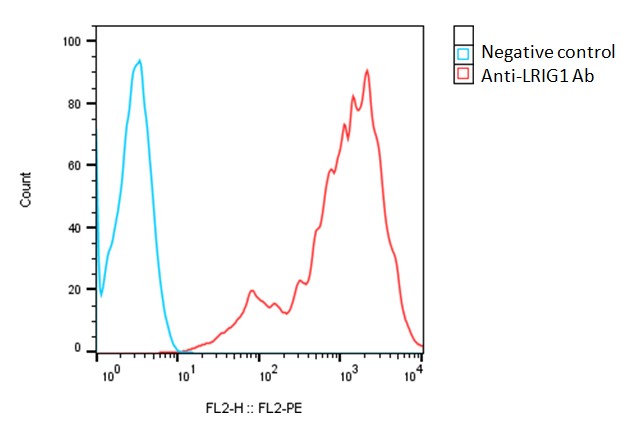
| Catalog Number | Product | Size | Price | |
|---|---|---|---|---|
| C3076 | Human LRIG1-CHO-K1 Stable Cell Line | 2 vials | $3950 | Order |
| Catalog Number | C3076 |
|---|---|
| Cell Line Name | Human LRIG1-CHO-K1 stable cell line |
| Accession Number | AAI40908.1 |
| Host Cell | Adherent CHO-K1 |
| Quantity | Two vials of frozen cells (2x106 per vial) |
| Culture Medium | DMEM with 10% FBS, 4 µg/ml puromycin |
| Freezing Medium | 90% FBS and 10% DMSO |
| Storage | Liquid nitrogen upon receipt |
| Product Datasheet: | Download PDF |
Detection of human LRIG1 expression on human LRIG1-CHO-K1 stable cells using a monoclonal antibody specific for human LRIG1, followed by staining with PE-anti mouse antibody.

LRIG1, also known as Leucine-rich repeats and immunoglobulin-like domains protein 1, is a transmembrane protein that plays crucial roles in various cellular processes like regulating cell proliferation, differentiation, survival, and apoptosis. It functions as a negative regulator of various receptor tyrosine kinases (RTKs), including EGFR (Epidermal Growth Factor Receptor), PDGFR (Platelet-Derived Growth Factor Receptor), and MET (Hepatocyte Growth Factor Receptor). By inhibiting RTK signaling, LRIG1 helps to maintain tissue homeostasis and suppresses tumorigenesis. LRIG1 is widely expressed in various tissues, including epithelial tissues such as skin, lung, intestine, and the central nervous system. Dysregulation of LRIG1 expression is associated with several cancers. In many cases, LRIG1 acts as a tumor suppressor by inhibiting RTK signaling and suppressing cell proliferation. Reduced expression of LRIG1 has been observed in cancers such as glioma, breast cancer, ovarian cancer, and squamous cell carcinoma of the head and neck. Conversely, LRIG1 overexpression has been reported in certain cancers like renal cell carcinoma and glioblastoma, suggesting context-dependent roles in tumorigenesis. Strategies aimed at restoring LRIG1 expression or enhancing its activity could help inhibit aberrant RTK signaling and suppress tumor growth. Additionally, LRIG1-based therapies may enhance the efficacy of existing cancer treatments, such as RTK inhibitors. Further research into LRIG1 function and its role in cancer biology is warranted to fully exploit its therapeutic potential.
Ji Y, Kumar R, Gokhale A, et al. LRIG1, a regulator of stem cell quiescence and a pleiotropic feedback tumor suppressor. Semin Cancer Biol. 82:120-133. 2022.
Ferguson KM, Blin C, Alfazema N, Gangoso E, Pollard SM, Marques-Torrejon MA. Lrig1 regulates the balance between proliferation and quiescence in glioblastoma stem cells. Front Cell Dev Biol. 10:983097. 2022.